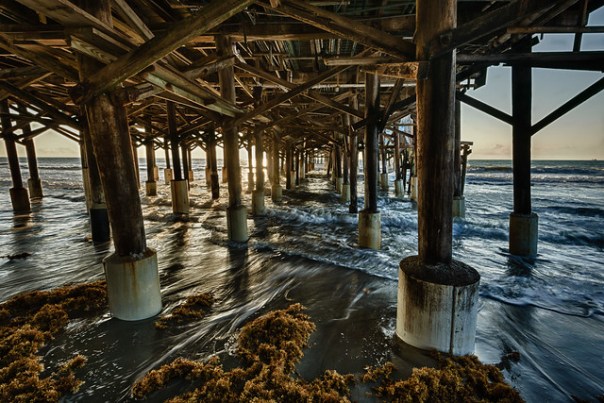Hello again, readers! I apologize for a somewhat lengthy post, but today I wanted to catch you up on photo related happenings over the last couple of weeks – so there are several topics worth mentioning.
Circle B Bar Reserve
A week ago (Saturday, 22 Jan), I returned to the Circle B Bar over in Lakeland Florida with the Photography Interest Group. The first time I wrote about this place, I said: “I’ve only been to the Circle B once, and need to go several more times to get an idea of how consistent the photo ops there are.” Well, the second visit lived up to the first, starting with a quite pretty dawn:

Dawn at the Circle B Bar Reserve
One of the highlights of this trip was seeing a Barred Owl and getting a relatively good photo of it. The owl was high in a tree and ended up attracting quite a crowd before it got tired of us and flew off. The lighting was a bit tough – I’m glad I had my flash and Better Beamer ready.
 Barred Owl watches photographers
Barred Owl watches photographers
We also sighted Ospreys, Red Shouldered Hawks, a Red Bellied Woodpecker, Whistling Ducks, and many other birds. Unfortunately, the beautiful yellow sunflowers that were all over the place last time are no longer there. They are seasonal and to see them you’ll have to return around mid to late November next year. All in all, a very nice trip and the Circle B definitely lived up to its reputation once again. You can look at more of my photos from the Circle B in this set on Flickr.
Black Point Wildlife Drive
Yesterday, I visited Black Point again. I’m not sure why, but this place seems to be really great for photos with reflections. Quite often the water is extremely calm and you can see scenes like these:
 Clear day, calm water
Clear day, calm water
 Spoonbill and reflection
Spoonbill and reflection
There was a lot of activity at Black Point. We spotted an otter, Hooded Mergansers, Belted Kingfishers, Hawks, and many other species. We also paused for a while to watch a pair of Ospreys fishing. They were too far away for good photos, and never came closer even though we had fish jumping out of the water right in front of us! You can look at more of my photos from Black Point in this set on Flickr.
Scrub Ridge Trail
A couple of weeks ago on Flickr, I saw some very nice photos of Florida Scrub Jays, made by “moonfloweryoli“. I commented on them and she mentioned a trail in Merritt Island National Wildlife Refuge where she saw them. This led us to an add a second expedition to yesterday’s Black Point visit. We wanted to try to observe this unique species that only lives here in Florida. To make a long story short, we tried hard, but we never saw any. We’ll have to go back and try again. Kevin K. did make this image to document our search:
 “Wilbur” and “Donuts” looking for the hard to find Florida Scrub Jay (image courtesy of Kevin Krause); Your humble author is the one on the left.
“Wilbur” and “Donuts” looking for the hard to find Florida Scrub Jay (image courtesy of Kevin Krause); Your humble author is the one on the left.
Alligator Farm and Gatorland blogs
A quick update for those of you looking for info on the St. Augustine Alligator Farm or Gatorland. I reported back in November that Gatorland was canceling its photographer early entry program. The Gatorland Blog hasn’t been updated since then, so it’s a bit hard to find out what’s going on at that park.
Meanwhile, the St. Augustine Alligator Farm announced they would continue their photographer early entry program. They’ve been running a mailing list on Yahoo where you could find information, and last week they announced that they’ll be discontinuing this and starting a blog of their own. It’s now up and running, check it out.
Sigma 150 – 500
Finally, here’s an equipment update. I’ve been doing much of my bird photography since early last year with a Sigma 150 – 500 OS lens. I’ve been very happy with it and one of my few complaints was that the Optical Stabilization was a bit noisy. Lately, it’s developed a “chatter” where it sounds like the OS motor is vibrating back and forth. While it does this, you can see the image vibrating through the viewfinder. I called Sigma and they said to send it back. So I’ll be without it for a while. I’ll let you know how it turns out.
That’s all for today. Thanks for stopping by.
© 2011, Ed Rosack. All rights reserved.
 Black Skimmer – Along the causeway headed into the Refuge
Black Skimmer – Along the causeway headed into the Refuge Roseate Spoonbill (BPWD)- This bird was foraging near the shore and ignored me as I crouched down and framed my shot. When it heard the shutter clicking, it stopped and stared right at me for a few seconds and then continued feeding.
Roseate Spoonbill (BPWD)- This bird was foraging near the shore and ignored me as I crouched down and framed my shot. When it heard the shutter clicking, it stopped and stared right at me for a few seconds and then continued feeding.
 Great Horned Owl on nest – The platform and nest have been there for a long time. My first sighting was 3 years ago.
Great Horned Owl on nest – The platform and nest have been there for a long time. My first sighting was 3 years ago.


































